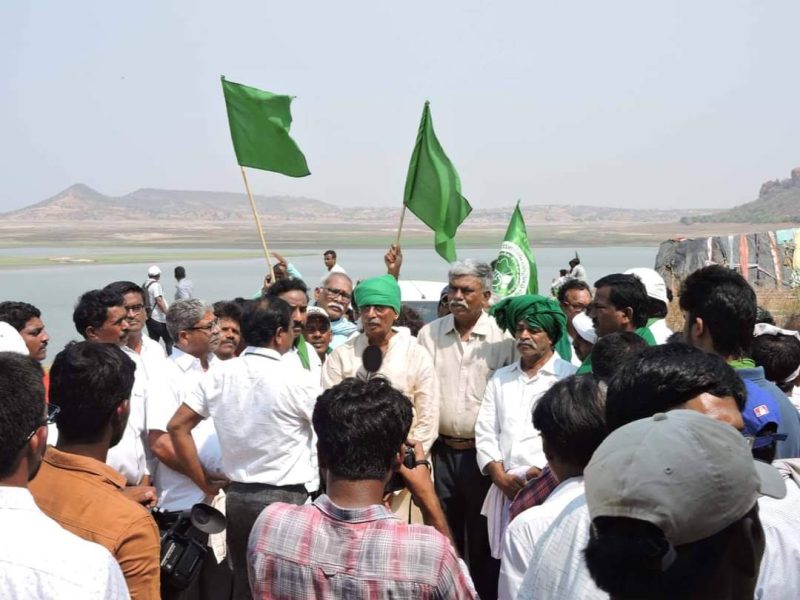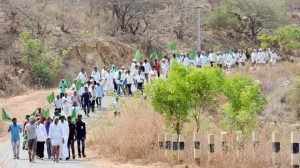
Rayalaseema hopes to get 3rd time lucky with Siddeswaram project to end its water woes
A protest is planned at Siddeswaram to demand a weir to divert Krishna waters to Rayalaseema; the region has been denied irrigation projects twice till date

The ‘Siddeswaram’ chant is often heard everywhere in Andhra Pradesh’s Rayalaseema region, which comprises the erstwhile districts of Kurnool, Kadapa, Anantapur and Chittoor. The people of the region consider the word as a synonym for ‘political victimisation’ and it is used as a rallying cry to demand justice for Rayalaseema.
This chant first took off on May 31, 2016, when thousands of people defied prohibition orders and descended on Siddeswaram village to perform a symbolic Praja Sankhusthapana, a foundation-laying ceremony for the construction of a weir, or a low dam, to divert Krishna waters to this region.
The weir never came about, but the event gave birth a tradition. On May 31 every year, people and activists observe Siddeswaram Day in various forms to highlight the apathy of the governments and legislators towards the water woes of the Rayalaseema people.
Jala Deeksha on Tuesday
This year, the day will again be observed with a march to Siddeswaram. Farmers, students, intellectuals etc., are expected to assemble at the spot on Tuesday (May 31) and perform ‘Jala Deeksha’, which will involve a puja and a public meeting.
According to Bojja Dasaratha Rami Reddy, president of the Rayalseeema Sagauniti Sadhana Samiti (RSSS), the group spearheading the movement, as many as 20 organisations are participating in the Jala Deeksha.

Curiously, neither the ruling YSR Congress nor the Opposition Telugu Desam Party is supporting the movement. While Chandrababu Naidu’s government tried to scuttle the yatra to Siddeswaram in 2016, the current Chief Minister YS Jaganmohan Reddy’s government is maintaining a stoic silence on the programme. Given the dispute between Rayalaseema and Coastal Andhra over Krishna waters, the government probably believes that silence is the best approach since any statement on the issue could backfire electorally.
“It is unfortunate that both Naidu and Jagan, who are incidentally from the Rayalaseema region, are refusing to recognise the importance of constructing the Siddeswaram weir that can store 50 tmc water at a meagre cost and without any land submergence,” said Rami Reddy.
“The Centre is planning a bridge across the Krishna river between Siddeswaram in Andhra and Somasila in Telangana. We want this bridge to be converted into a weir, as compensation for the injustice done to the region due to the abandonment of the Siddeswaram project twice. At least this way 50 tmc of water can be stored during the flood season and it will not affect the interests of the regions downstream. Since the ruling parties are not responding, we are forced to mobilise people for the Siddeswaram weir.”
Also read: Amalapuram violence: Status of Dalits in Konaseema offers a unique case
What is Siddeswaram?
Siddeswaram is actually the spot where once a village existed. The village got submerged in the backwaters of the Srisailam Reservoir in the 1960s.
Then why would people organise commemoratory meetings for a little known remote village in an arid region? “The drowning of Siddeswaram in Krishna waters was also the burial of the hopes of Rayalaseema people, who had been crying for water for irrigation and drinking for ages. The non-existent Siddeswaram is like an unbuilt monument. The people come here to remember the injustice and take a vow to fight for justice,” explained KC Kalkura, an advocate and activist from Kurnool.
The First Assault on Siddeswaram
The village shot into fame when the Madras government wanted to harness Krishna and Pennar water for the benefit of the Rayalaseema, Nellore and Tamil regions. An investigation commenced in 1947 and a plan for a project called ‘Krishna-Pennar Scheme’ was finalised in 1951. The scheme envisaged the construction of two dams, one on the Krishna at Siddeswaram in Kurnool district and the other at Someswaram in Nellore district on River Pennar.
It was expected to cover an irrigational area of 21.96 lakh acres in the 1st stage, and 32.94 lakh acres in the 2nd stage. The scheme also provided for feeding of the Mylavaram reservoir with a discharge of 1,800 cusecs through a proposed Krishna-Pennar West Canal that would irrigate 1.5 acres in Kadapa district.
C Rajagopalachari (Rajaji), who became CM of composite Madras state after the 1952 elections, accorded top priority to the project. The Planning Commission also included it in the first Five-Year Plan. This issue coincided with the agitation for a separate Andhra state for the Telugus. The charge that Rajaji was taking Krishna waters to a region which was not part of the Krishna basin at the cost of Coastal Andhra added fuel to the separatist movement.
Despite being sceptical of the demand for an Andhra state made by coastal leaders, the Rayalaseema region leaders were lured by future political prospects and joined the chorus. Finally, the project was shelved based on the recommendations of the AN Khosla Committee, submitted in 1953.
In 1953, Andhra state was carved out from Madras state. This led to the scrapping of the Siddeswaram project and the end to Rayalaseema’s dreams for water supply.
Also read: Andhra petrol bunks in doldrums as vehicle owners zip past to Karnataka for cheaper fuel
The Second Assault
This occurred after the formation of Andhra Pradesh in 1956 with the merger of Andhra and Hyderabad states. The Technical Committee of the Planning Commission of India headed by AN Khosla, while abandoning Rajaji’s Krishna-Pennar Scheme as impracticable, recommended three reservoirs instead, namely, Nandikonda (first stage), Siddeswaram (second stage) and Pulichintala (third stage).
According to the report, the second stage “comprises the construction of a dam at Siddeswaram with an FRL of plus 885 ft (against plus 898·5 ft proposed in the Krishna-Pennar Project), the Krishna-Pennar Link canal (generally on the lines proposed in the Krishna-Pennar Project but with capacity reduced from 75,000 cusecs to 10,000 cusecs and the Mottakondala cutting replaced if possible by a tunnel), and the Krishna-Pennar West Canal for direct irrigation only and not for feeding the Gandikota reservoir also as proposed by Madras.”
In the new state of Andhra Pradesh, Nandikonda (Nagarjuna Sagar) project was taken up and the Siddeswaram project was abandoned for the second time. In the place of Siddeswaram, a hydel project across Krishna, near Srisailam in Kurnool district without any irrigation component, was planned.
“The project should have been a multi-purpose project. But, the Centre insisted that power generation was the top priority of the nation. None from Rayalaseema, including the then CM N Sanjiva Reddy, could convince the Centre that Rayalaseema was being denied water for the second time. Nobody wanted to antagonise the influential Coastal Andhra region. The projects planned as successors of the Krishna-Pennar scheme were completed without benefiting Rayalaseema,” said V Sankaraiah, a veteran journalist and irrigation expert from the Chittoor district.
Also read: BJP demands Jinnah tower in Andhra town be renamed after Abdul Kalam
The Third Assault
The Centre is now planning to build a National Highway between Nandyala in AP and Kalwakurthy in Telangana. This requires the construction of a bridge across the Krishna between AP’s Siddeswaram and Somalsila of Telangana. The people of the regions believe this is an opportunity to get their ‘Siddeswaram’ dream realised at least in the form of a weir.
The RSSS group has demanded that the bridge be converted into a barrage to divert water from the Krishna to Rayalaseema. Many people in the region felt that if they miss this opportunity, Siddeswaram would be gone forever.
“Converting a bridge into a barrage is easier at a minimal cost of ₹350 crore. It won’t need any separate allocation of water as it would store only the floodwater. It’s a great opportunity for the government as well to address the long-felt water needs of Rayalaseema. We cannot afford to lose this opportunity,” said Rami Reddy.
“But, the government is not able to take a stand on the barrage. Because CM Jaganmohan Reddy, like his predecessors, doesn’t want to be seen as a leader of his home region. Support from Coastal Andhra is critical for the survival of any CM of Rayalaseema origin. All chief ministers, right from Neelam Sanjeeva Reddy to Jaganmohan Reddy, played it safe when dealing with matters related to the interests of the Rayalaseema region. So, they do not hesitate to undermine the region’s interests to placate the coastal Andhra leaders and voters,” alleged Somasekhara Sarma, convenor of the Rayalaseema Vidyavantula Vedika.
Call for quick intervention
Sankaraiah also pointed out, “In 1975, when the Bachawat Commission allocated water to various projects based on the projects under construction, Rayalaseema could not get anything because the region had none. Had the Krishna-Pennar Project been constructed, it could have gotten its own share. Later, had the Srisailam been built as a multi-purpose project, there could have been a water allocation. Now, after the Krishna River Management Board notification, not a drop can be drawn by any state. Against this backdrop, Siddeswaram, even in its latest avatar as a small weir, requires immediate intervention by the government.”
The yatra organisers have said requests made to CM Jagan on this issue have gone unattended. Meanwhile, no official comment on the demand for the Siddeswaram weir and the proposed protest march was available from the government. A senior official, however, said, he was not aware of any such project proposal pending with the government.


